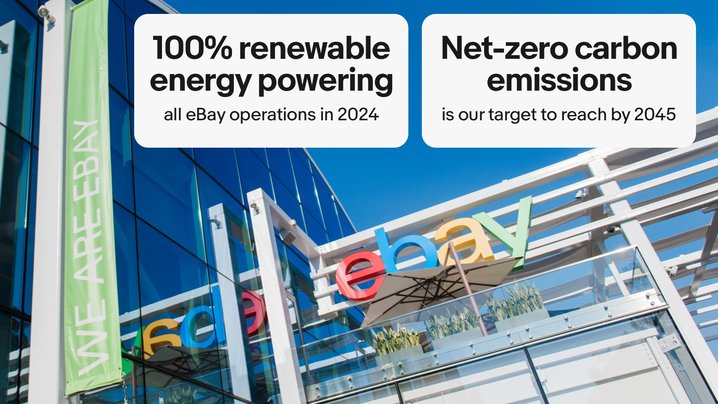100% renewable energy supported all eBay operations in 2024.
By innovating and evolving our platform and operations, we’re building a marketplace that powers economic opportunity and a more sustainable future.

At eBay, commerce and sustainability go hand in hand.
Our vision for an economically empowering, sustainable marketplace drives us to improve our platform and operations, so that meaningful commerce can be more accessible and rewarding for everyone. When our community wins, we win. And when we win because of sustainability, we set a new standard for the tech industry and beyond.
2024 was a key year for our sustainability journey. eBay’s operations were 100% supported by renewable energy, and we’ve accelerated decarbonization efforts in transportation and distribution. Next, we're setting our sights on net-zero emissions across our value chain by 2045.
We’re proud to continue growing from a circular business model that extends the life of products, reducing waste and empowering sustainable shopping. In 2024, recommerce generated $5 billion in positive economic impact, and avoided 1.6 million metric tons of carbon emissions and 70,000 metric tons of waste.
We're eager to build on this momentum and continue uplifting our customers while promoting a healthier planet.
Environmental Footprint
As a global marketplace, eBay has an important role to play in creating a more sustainable future. We hold ourselves to a high standard for climate action, and continuously set, achieve, and evolve ambitious goals in service of a greener, decarbonized world.
Greenhouse Gas Emissions
We report our GHG emissions in accordance with the World Resource Institute’s Greenhouse Gas Protocol. We set a science-based target using SBTi criteria to reduce Scopes 1 and 2 emissions by 90% by 2030 from our 2019 baseline. Data coverage includes 100% of our operations.
Emissions by Scope
Our corporate footprint consists primarily of our offices, which account for 68% of our direct Scopes 1 and 2 emissions. Remaining Scope 1 emissions come from fuel combustion at our facilities and direct business travel. Notably, our investment in renewable energy has nearly eliminated our Scope 2 footprint. As with most companies, our Scope 3 emissions significantly outweigh our Scopes 1 and 2. As an online marketplace, the majority of our value chain emissions come from the delivery of products.
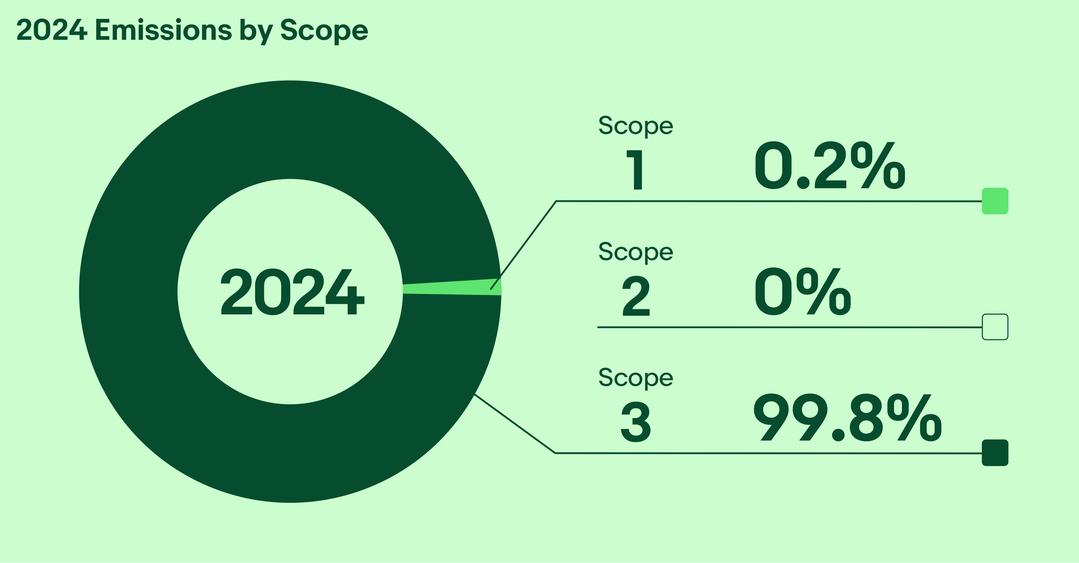
About this chart: Greenhouse Gas Emissions
Pie chart showing the breakdown of our greenhouse gas emissions, with Scope 1 making up 0.2%, Scope 2 making up 0% and Scope 3 making up 99.8% of our total emissions.
Scopes 1 and 2
In 2024, we continued to roll out energy-saving upgrades, including the installation of efficient lighting at several U.S. and global locations. Our data centers have also been equipped with more efficient cooling systems to reduce operational energy use. Energy efficiency strategies like these have contributed to a 92% reduction in our Scope 1 and 2 emissions from our 2019 baseline.
The reduction in Scope 2 emissions from 2023 to 2024 was primarily driven by our strategic approach to renewable energy procurement and the allocation of offsite bundled Renewable Energy Certificates (RECs) from virtual power purchase agreements (VPPAs), from our colocation data center providers, and a small number of purchased unbundled RECs for global offices. We allocated VPPA RECs to our data centers and Salt Lake City sites, which are the largest energy consumers where local renewable electricity solutions are not readily available. This approach resulted in a significant reduction in Scope 2 emissions* and enabled us to achieve our 100% renewable energy and RE100 goal a year early.
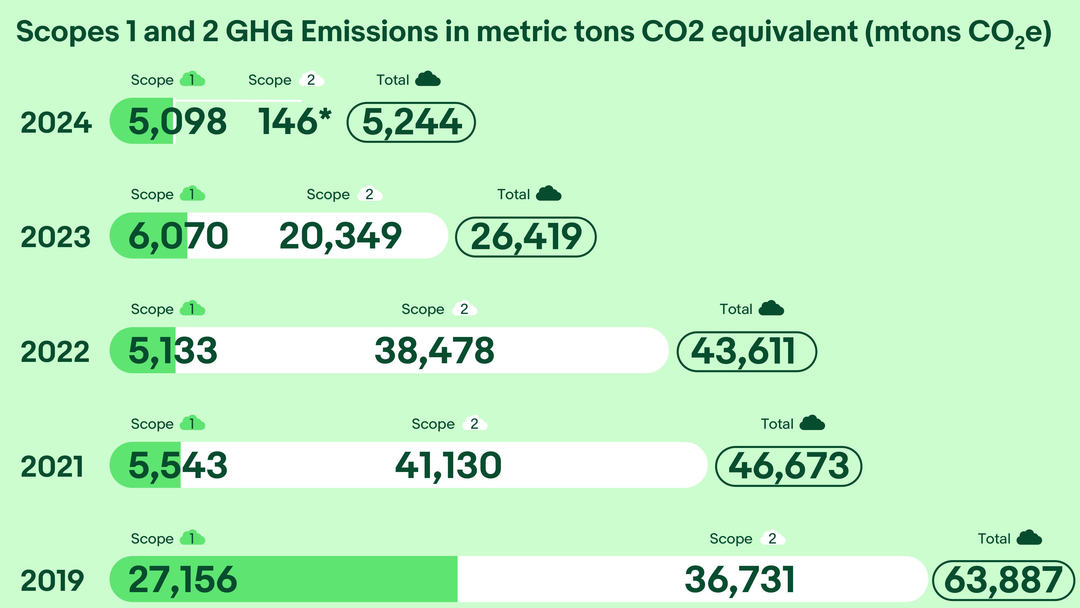
About this chart: Scopes 1 and 2 Emissions
Chart illustrating Scopes 1 and 2 GHG emissions from 2019 to 2024, showing a consistent year-over-year decrease. In 2019, total emissions were 63,887 mtons CO2e (Scope 1: 27,156; Scope 2: 36,731). 2020 data is unavailable. In 2021, emissions decreased to 46,673 mtons CO2e (Scope 1: 5,543; Scope 2: 41,130). In 2022, emissions further reduced to 43,611 mtons CO2e (Scope 1: 5,133; Scope 2: 38,478). By 2023, emissions dropped to 26,419 mtons CO2e (Scope 1: 6,070; Scope 2: 20,349). In 2024, emissions decreased to 5,244 mtons CO2e (Scope 1: 5,098; Scope 2: 146*). *Note: Scope 2 market-based emissions total is reported in alignment with the GHG Protocol’s Scope 2 Guidance. In South Korea and Singapore, energy attribute certificates (EACs) were applied outside of relevant market boundaries as in-market EACs were not readily available. Scope 2 market-based emissions total excluding EACs outside of market boundaries is 0 mtons CO2e.
Scope 3
In 2024, our Scope 3 emissions were primarily generated through downstream transportation and distribution (T&D) of items purchased on our platform. Our other significant category of Scope 3 emissions is purchased goods and services. We refined the way we track and measure Scope 3 emissions across categories in 2024.
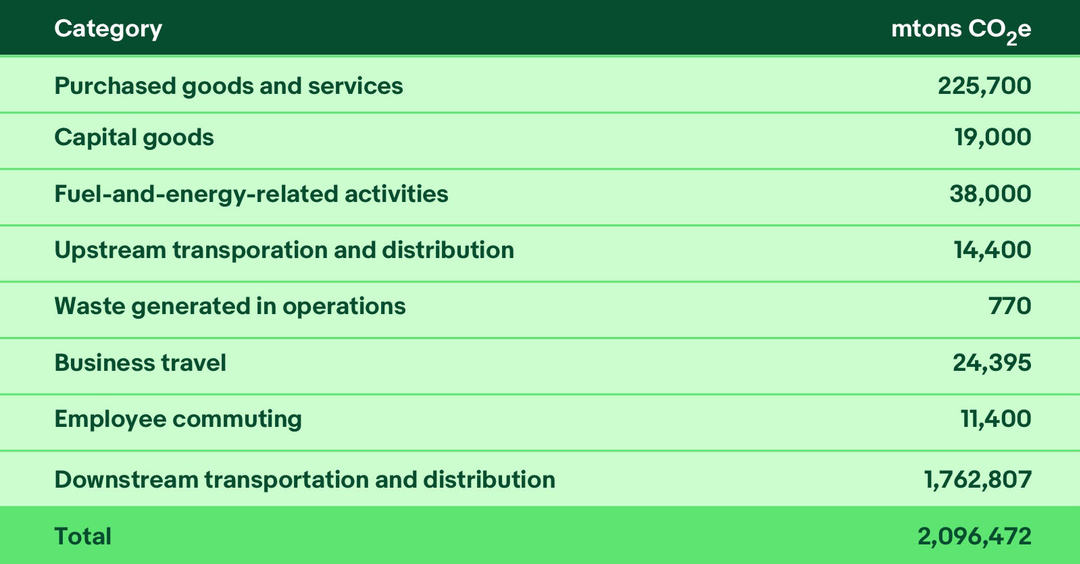
About this chart: Scope 3 GHG Emissions by Category
Chart showing category breakdown of our Scope 3 emissions in 2024. Contributions include 225,700 mtons CO2e from purchased goods and services, 19,000 mtons CO2e from capital goods, 38,000 mtons CO2e from fuel-and-energy-related activities, 14,400 mtons CO2e from upstream T&D, 770 mtons CO2e from waste generated in operations, 24,395 mtons CO2e from business travel, 11,400 mtons CO2e from employee commuting, and 1,762,807 mtons CO2e from downstream T&D.
Scope 3 Downstream Transportation and Distribution (T&D)
In 2024, approximately 84% of our total Scope 3 emissions were generated by the shipping and transportation of items purchased on our platform. The increase in emissions from 2023 to 2024 was primarily driven by shipments traveling longer distances and at a higher weight per package on average.

About this chart: Scope 3 Shipping
Chart showing year-over-year changes in Scope 3 Shipping emissions: 2,244,000 mtons CO2e in 2019, 1,836,000 mtons CO2e in 2021, 1,477,000 mtons CO2e in 2022, 1,429,419 mtons CO2e in 2023, and 1,762,807 mtons CO2e in 2024.
Energy
Like other technology companies, our largest direct environmental impact comes from energy consumption in our offices and data centers. To address this, we are committed to investing in clean energy sources, with a goal to support all our electricity consumption with renewable energy.
Energy Use
We continuously optimize our energy usage to minimize eBay’s environmental impact. Across our data centers, we’re addressing electrical redundancies and retrofitting power supply systems with high-efficiency models. To stay ahead of the growing demand for artificial intelligence (AI), we're proactively exploring solutions and investment opportunities to mitigate expected increases in energy use. Finally, we’ve upgraded the Building Automation and lighting systems at our headquarters, and replaced traditional lighting with LEDs in Shanghai, Bern, and Milan.

About this chart: Energy Use by Type
Chart showing the breakdown of energy use from 2021 to 2024 by energy type. In 2021, our offices, authentication centers and data centers used a total of 402,674 MWh of energy: 373,987 MWh of electric power, 25,538 MWh of natural gas, and 3,149 MWh of other energy. In 2022, we used 410,202 MWh of total energy: 386,323 MWh of electric power, 19,761 MWh of natural gas, and 4,118 MWh of other energy. In 2023, we used 438,194 MWh of total energy: 415,100 MWh of electric power, 16,983 MWh of natural gas, and 6,111 MWh of other energy. In 2024, we used 463,826 MWh of total energy: 440,053 MWh of electric power, 18,011 MWh of natural gas and 5,762 MWh of other energy.
Renewable Energy
We are proud to say that our San Jose headquarters and seven other offices use 100% renewable energy through their utility providers. We have also invested in virtual power purchase agreements (VPPAs) in Texas and Louisiana. In 2024, our third VPPA became operational, and we refined our renewable energy procurement strategy for global offices, authentication centers, and colocations. These efforts enabled us to achieve our 100% renewable energy and RE100 goal a year early.
To maintain this goal, we will continue to prioritize local green programs and VPPAs when feasible and monitor increases in overall electricity usage.
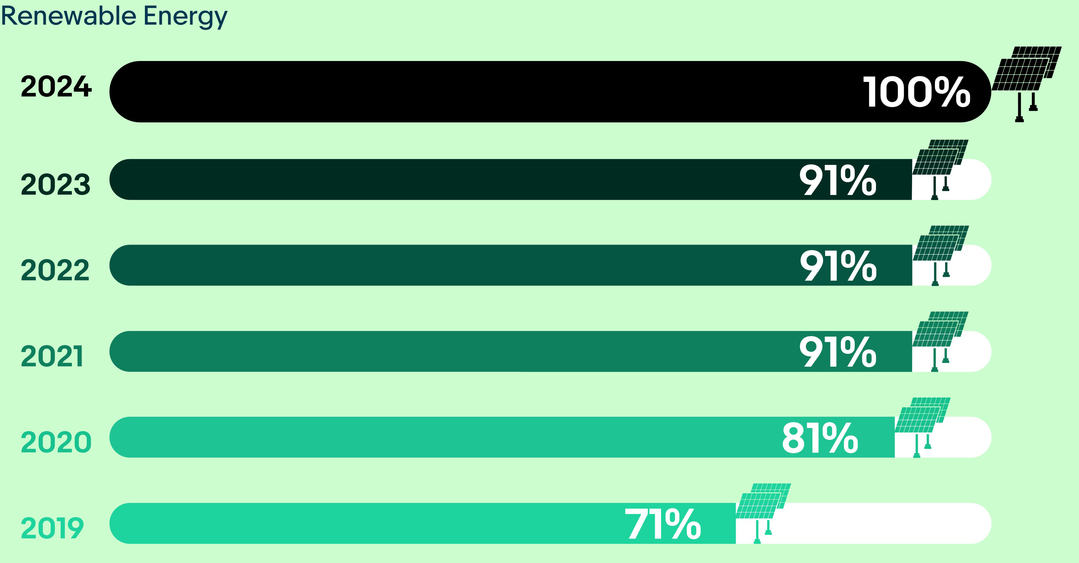
About this chart: Renewable Energy
This chart shows that eBay-controlled offices, data centers, and authentication centers have increased their electricity supply from renewable energy sources from 71% in 2019, to 81% in 2020, to 91% in 2021 through 2023, to 100% in 2024.
EPA Green Power Partnership
Since 2020, we have been an official member of the U.S. Environmental Protection Agency’s (EPA) Green Power Partnership, which encourages organizations to reduce the environmental impacts of conventional electricity by using green power. In 2024, we were once again included in the partnership’s Top 30 Tech & Telecom list, which highlights top Green Power Partners in the technology industry.
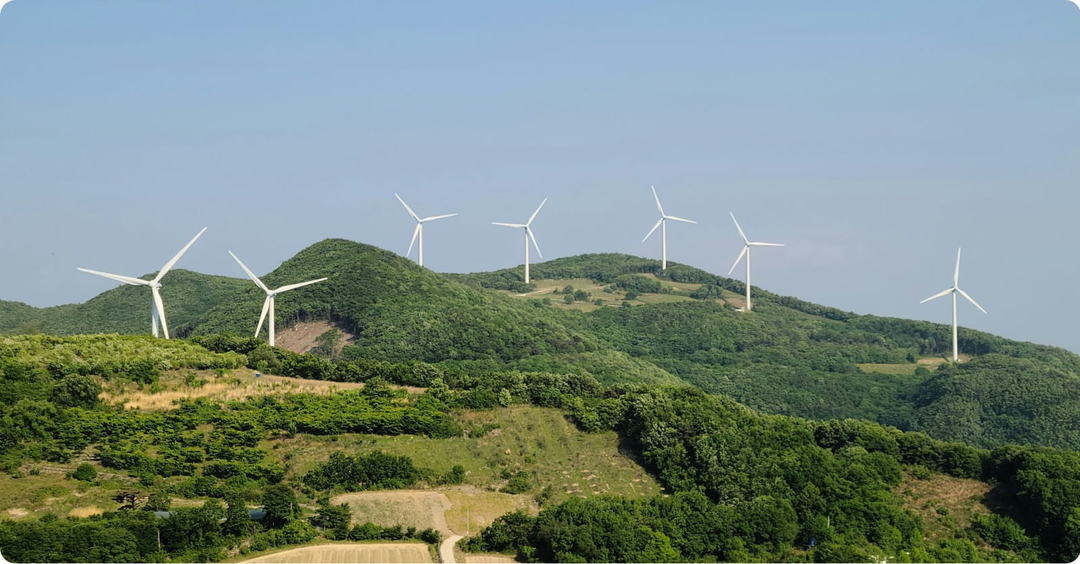
Shipping
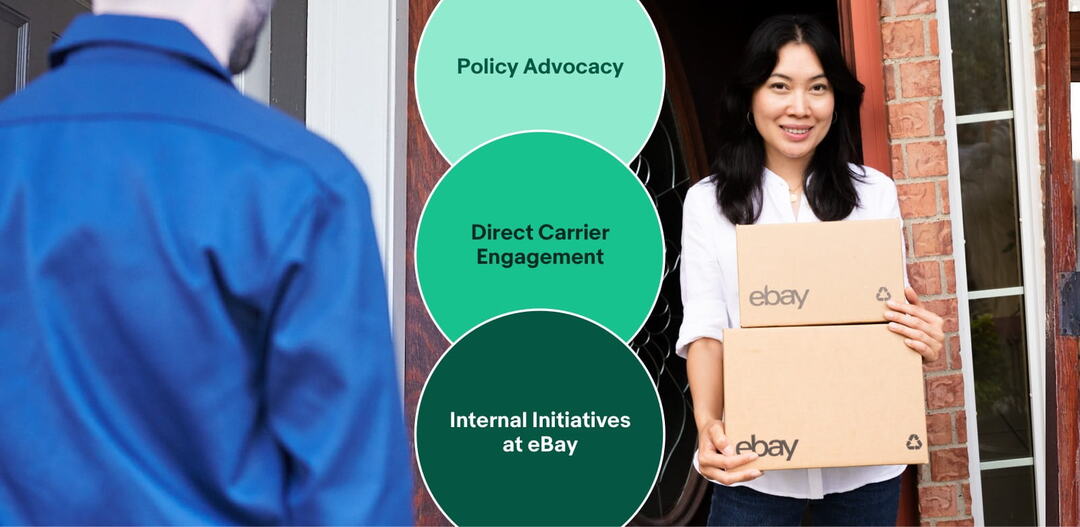
In 2024, we made great strides in improving measurement and partnering with our carriers to support decarbonization of our shipping-related emissions.
We progressed our decarbonization journey by leading powerful collaborations across the transportation and distribution (T&D) industry. This year, we partnered with EVRi, a parcel delivery and courier service, to bring more electric vans to the road in the U.K., DHL to support sustainable aviation fuel (SAF) procurement in Japan, and the U.S. Postal Service to reduce delivery emissions by encouraging the shifting packages from air to ground transportation.
We developed a Carrier Engagement guide, which standardizes our sustainability expectations for carriers and outlines a collaborative roadmap for decarbonization. By sharing with industry peers, shippers, and carriers, we're promoting best practices for sustainable shipping, setting clear minimum sustainability requirements for our carrier partners, and fostering industry-wide alignment. We also made public our Methodology to Calculate Downstream Transportation and Distribution Emissions to help other shippers standardize around emissions calculation and decarbonization efforts tracking.
We're building partnerships to advance decarbonization policies in the transportation sector. As founding members of the Center for Green Market Activation, we're working to reduce emissions from long-haul road shipping. Additionally, our first-of-its-kind summit during New York Climate Week brought together companies and non-governmental organizations (NGOs) to tackle the unique decarbonization challenges of post and parcel shipping.
Internally, we're scaling local delivery, promoting ground shipment over air to our sellers and buyers, and exploring technologies like sustainable aviation fuel to further reduce our carbon footprint.
Water and Waste
We’re continuing to advance water conservation and waste reduction across our global offices.
Water Consumption
Water consumption remains a top priority. We work to ensure our water use data collection is precise, and we annually perform a global water risk assessment. In Shanghai, we replaced all toilets with water-efficient models to reduce water waste, and we have installed additional touchless faucets at several office locations.
Our water use rose in 2024 as more of our sites began reporting their consumption and because of increased energy demand and construction at our primary data center.
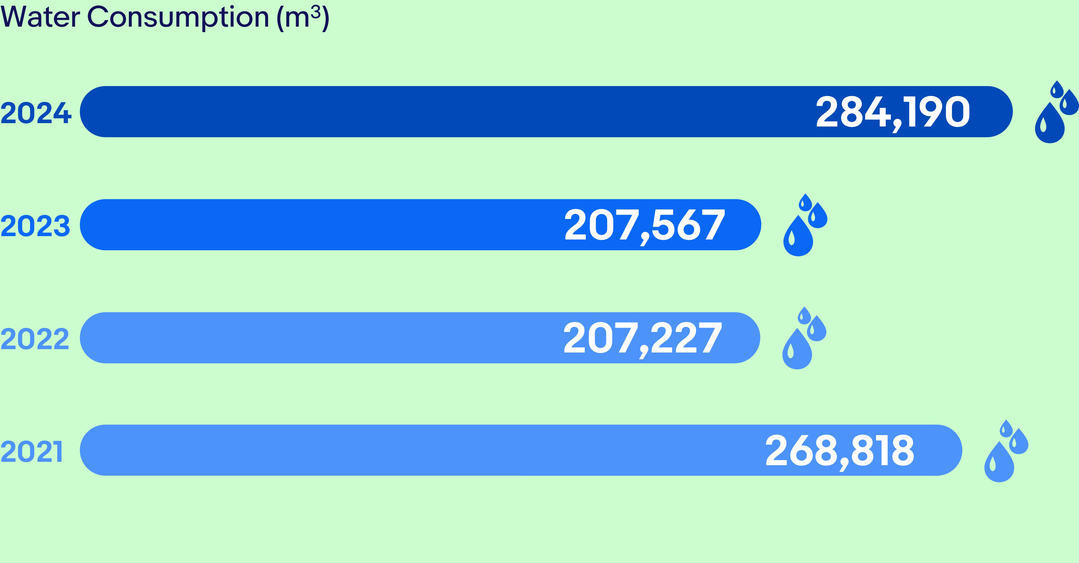
About this chart: Water Consumption
Chart showing changes in water consumption from 2021 to 2024, from 268,818 m3 in 2021, to 207,227 m3 in 2022, to 207,567 m3 in 2023, and to 284,190 m3 in 2024. *This includes only sites with available water consumption data, and is not a complete representation of eBay’s total water consumption. Data collection for additional sites is still in progress, and we continue to work to increase the number of reporting sites year-over-year.
Waste Diversion
We remain committed to reducing the amount of waste that leaves eBay-owned sites. At our U.S. offices in Austin, NYC, and San Jose, we now procure primarily eco-labeled office supplies, compostable cafe products, and green cleaning chemicals and supplies. We also expanded waste reduction efforts in Dublin, Ireland by eliminating paper cups and sauce sachets, opting for reusable cups and sauce dispensers. In San Jose, we switched to a socially responsible food service provider, Bon Appétit, that offers organic and locally-sourced food and is dedicated to minimizing their climate impact. We also implemented Bon Appétit’s WasteNot™ program to monitor and optimize waste streams in our cafeteria, and we have maintained a high waste diversion rate across all operations at headquarters. Finally, we continue to refine our waste data collection process and expand reporting to additional global sites.
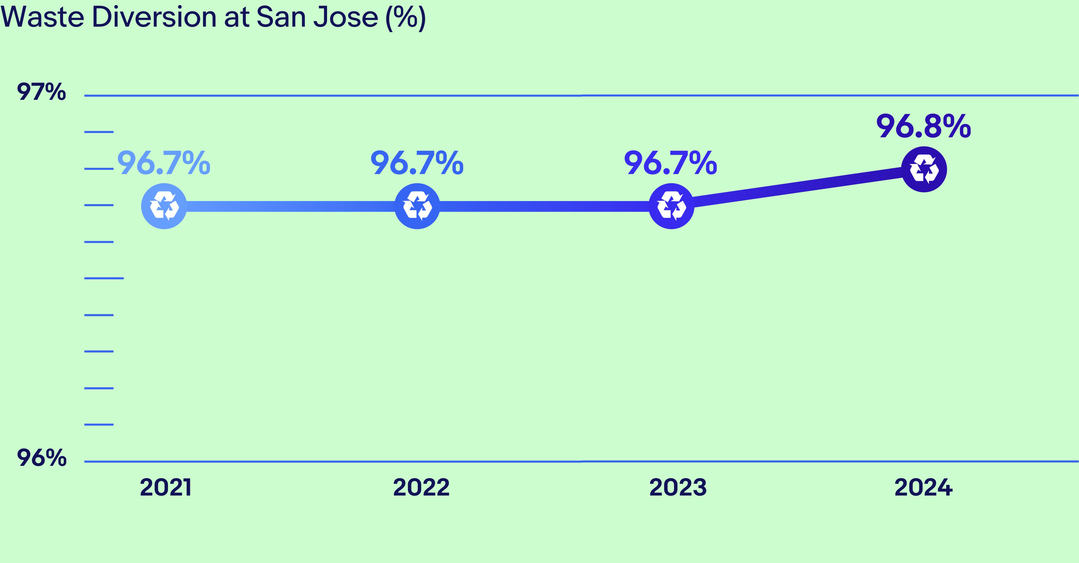
About this chart: Waste Diversion
Chart showing our waste diversion rate, which was 96.7% from 2021 to 2023, then 96.8% in 2024.
Biodiversity
We continue to seek opportunities to protect biodiversity and limit our impact on local ecosystems.
Biodiversity Risk Assessment
In early 2024, we conducted an analysis of our locations and examined their proximity to protected areas. This assessment evaluated potential risks across eBay’s portfolio of properties, including in metro areas where eBay has a large presence. While none of our locations were deemed high-risk, we continue to monitor each site closely for climate, biodiversity, or nature risks and impacts.

Key Sustainability Partnerships
We partner with several organizations to advocate for climate action and advance sustainable business practices.
eBay’s memberships include:
- Clean Energy Buyers Association (CEBA)
- Ceres Policy Network’s Business for Innovative Climate and Energy Policy (BICEP) coalition
- Ellen Macarthur Foundation
- RE100
- U.S. Environmental Protection Agency’s (EPA) Green Power Partnership
- Utah Clean Energy Coalition

Circular Fashion Fund
In October 2024, eBay expanded its Circular Fashion Fund (CFF) into the U.S. and Germany, following successful pilots in the U.K. and Australia. Designed to help fashion startups scale circular solutions, from production to end-of-life, CFF plans to invest $1.2 million by the end of 2025 and offer over 200 hours of expert mentoring and networking support worldwide.
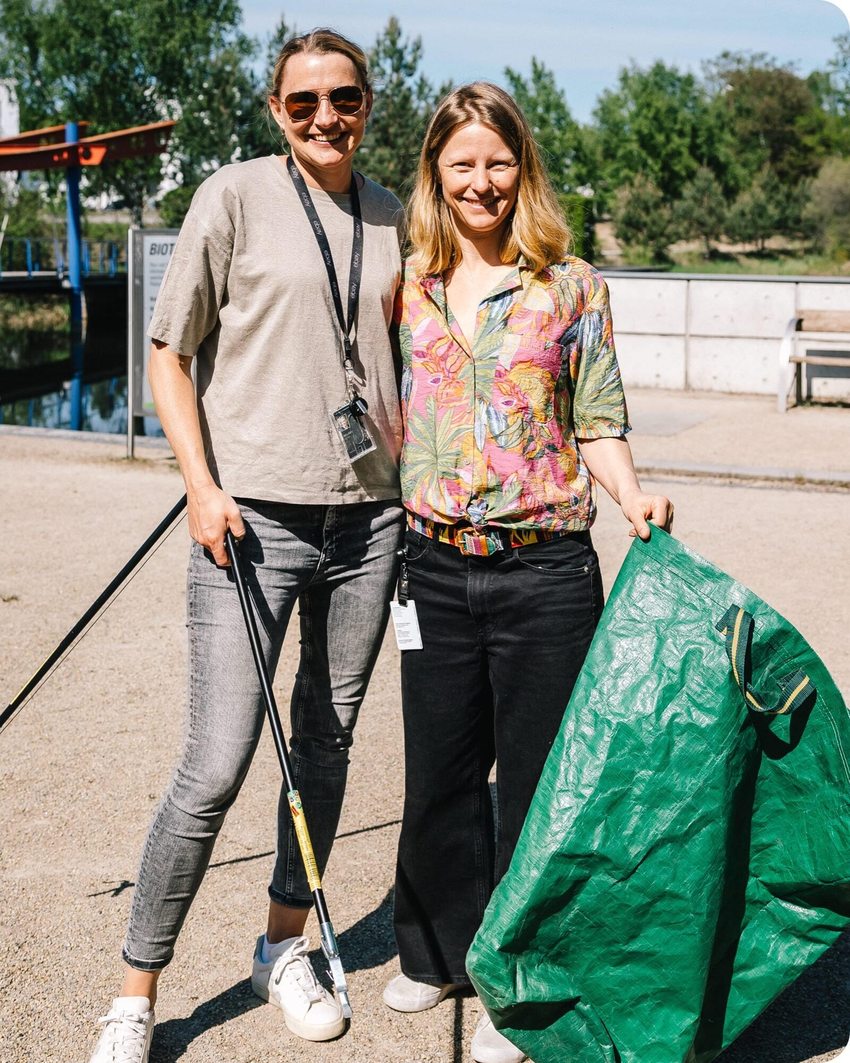
Sustainability in Germany
Colleagues at eBay’s office in Dreilinden are setting an example for taking action toward a sustainable future.
Recommerce
We pioneered recommerce, or circular commerce, with the first sale on our marketplace in 1995: a pre-owned laser pointer, purchased by someone who wanted to fix it and give it a second life.
Promoting the Circular Economy
Recommerce has been central to eBay’s marketplace since day one.
Recommerce is proof that sustainability and opportunity can go hand in hand. When we connect buyers and sellers through the resale of pre-loved and refurbished goods, we’re also reducing waste, conserving resources, and cutting greenhouse gas emissions.
As of 2024, over 40% of our sales come from pre-owned and refurbished items. Meanwhile, recommerce continues to grow in popularity, with sales of “thrifted” clothing, shoes, and accessories on eBay surging by over 400% globally in March 2024 (versus March 2023). To understand the trends and sentiments driving this, we surveyed over 28,000 consumers worldwide, within the eBay community and beyond, for our latest Recommerce Report. The report found that three in five consumers had bought pre-loved goods in the past 12 months, and over 70% intended to do so the following year.
We're proud to be at the forefront of the circular economy movement. To drive awareness and further our impact, eBay collaborated with actor and sustainability advocate Alicia Silverstone for our Recommerce Day – a moment to highlight the benefits of recommerce and encourage more sustainable shopping practices.
Our efforts to drive sustainable entrepreneurship through recommerce have earned us recognition in the Fortune Change the World 2024 List, underscoring our commitment to sustainable commerce.

eBay Refurbished
We support a circular economy through our eBay Refurbished program, extending product lifecycles and reducing the need for environmentally costly new manufacturing.
Our Certified Refurbished items are expertly refurbished, 100% functional, and come with a one- or two-year warranty. eBay shoppers can purchase refurbished items directly from top sellers and more than 400 brands.
In 2024, we expanded the number of products and sellers in the program to make the sustainability benefits of refurbished goods even more accessible. Additionally, we introduced Seller Refurbished items from top-rated sellers, meeting rigorous performance standards.


